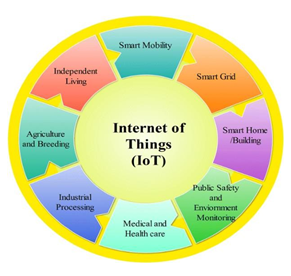Developing IOT Applications Challenges and Frameworks
Tagged: Computer Science
Introduction
The Internet of Things (IoT) is based on the concept of connecting existing and future physical devices to the Internet. The IoT is defined as the connection of a significant number of physical items to the Internet, with the goal of making high-level interactions with the physical world as simple as engaging with the virtual world. The Internet of Things (IoT) connects the physical world of things to the virtual world of information. IoT enables physical world items to be embedded with identification, sensing, networking, and computing capabilities, allowing them to connect with one another through the Internet to achieve certain goals1 .

Natural Language Processing (NLP)2
Iot Applications Framework
Transportation and logistics, healthcare, retail and supply chain, industry, and the environment are just a few of the areas where IoT applications have been created and deployed. Despite their widespread use, IoT application development remains difficult and time-consuming. This is due to the fact that it entails addressing a number of linked challenges, such as the failure to properly identify the roles of various stakeholders and the absence of appropriate frameworks to address the large-scale and heterogeneity of IoT systems . Another significant challenge is developing effective programming abstractions at various technology layers, from device software to middleware services and end-user applications.
These issues lengthen the development process, consume more resources, and cause the deployment of IoT applications to be delayed. Because of the intricacy of IoT applications, they should not be developed haphazardly, necessitating the use of a framework. An IoT application framework can make the tough task of dealing with heterogeneous devices and software components, overcoming the difficulties of distributed system technologies, processing a large volume of data, establishing an application architecture, implementing it in a programme, writing particular code to validate the application, and eventually deploying it much easier .3 .
Iot Application Challenges
The key requirements of IoT applications are aided by the nature of the technology architecture. A set of key needs for IoT applications is outlined based on the features of the IoT technological ecosystem, such as heterogeneity, massive scale, huge amount of data, and dynamism, as defined in. These requirements, when paired with the quality criteria stated in, can be utilised to create a set of high-level IoT application requirements. The list is not exhaustive, but it enumerates the most significant challenges encountered during the procurement process .
Security
Because of the huge number of devices, services, and people connected to the internet, privacy, trust, secrecy, and integrity are considered crucial security concepts for IoT. These are the most important and necessary requirements for IoT applications. Because the IoT application consumes data in a variety of formats, at varying speeds, and from a variety of sources, it's critical that it includes privacy and confidentiality-enforcing trust mechanisms. In addition, IoT applications must include procedures to check for data integrity in order to avoid IoT apps operating incorrectly .
Adaptability
IoT systems will be made up of a number of resource-constrained mobile nodes that are connected to the Internet via a wireless connection. Nodes can be linked and disconnected from the system at any time due to reasons such as poor connectivity and power shortages. In addition, the state, location, and computation speed of these nodes can all change over time. All of these reasons contribute to the high dynamic nature of IoT systems. Self-optimizing, self-protecting, and self-configuring IoT applications should be resilient and efficient .
Intelligence
The IoT's building blocks are intelligent things and systems of systems. IoT applications will enable IoT enabling technologies to transform commonplace items into smart things capable of understanding and obtaining intelligence by making or enabling contextrelated decisions, culminating in task execution without human intervention. To achieve this, IoT applications must be built using intelligent decision-making approaches such as contextaware computing, predictive analytics, complex event processing, and behavioural analytics4
Real Time
The timely supply of data and services is required in a number of IoT domains. Consider IoT in settings like telemedicine, patient care, and vehicle-to-vehicle interactions, where a delay of just a few seconds can be fatal. IoT applications that provide on-time delivery of data and services will be required in environments where operations are timecritical5 .
Regulation Compliant
IoT apps may capture sensitive personal data about people's daily activities, such as detailed energy usage profiles and travel histories. Many people see this information as private. When such information is accessible to the Internet, there is a risk of privacy leakage, which could jeopardise an individual's privacy. IoT apps must comply with privacy requirements specified by legislation, such as EU data protection standards, in order to avoid violating people's privacy; otherwise, they may be disallowed6 .
Conclusion
Health, transportation, and agriculture are just a few of the areas where IoT applications are being used more frequently. IoT applications, unlike traditional software, rely on a diverse range of technologies and components. Furthermore, IoT stakeholders demand technical expertise as well as a thorough understanding of domain knowledge. IoT application development is complicated, time-consuming, and challenging because of these issues7 .
Reference
- https://sci-hub.se/10.1007/s11277-019-06407-
- https://link.springer.com/article/10.1007/s11277-020-07446-4
- https://sci-hub.se/10.1109/comst.2019.2943087
- https://sci-hub.se/10.1109/mcom.2019.1800332
- https://sci-hub.se/10.1145/3266237.3266263
- https://sci-hub.se/10.1016/j.sysarc.2019.04.003
- https://sci-hub.se/10.1109/FIOT.2018.8325595

